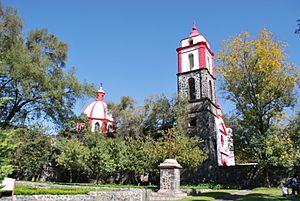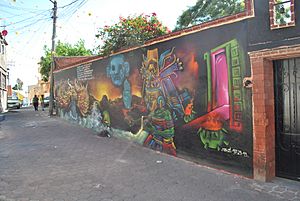Pueblo Culhuacán facts for kids
Quick facts for kids
Pueblo Culhuacán
|
|
|---|---|
|
Neighborhood of Mexico City
|
|

View of the monastery of Culhuacán
|
|
| Country | |
| City | |
| Borough | Iztapalapa |
| Postal code |
09800
|
Pueblo Culhuacán is a special neighborhood in Iztapalapa, a part of Mexico City. Long ago, it was a very important ancient city. People have lived here for a very long time, since about 600 CE (that's over 1400 years!).
The powerful Aztecs took over in the 1400s. But they respected Culhuacán so much that their leaders married into its noble families. After the Spanish arrived, Christian missionaries built a big monastery here. This monastery is still standing today. In 2011, Culhuacán was named a "Barrio Mágico" (Magic Neighborhood) by Mexico City.
Contents
Pueblo Culhuacán Today
Culhuacán is one of the areas within the Iztapalapa borough. It is located at the base of the Cerro de la Estrella mountain. Today, the Culhuacán area is divided into smaller parts called "colonias" or "barrios." The historic center is known as Pueblo Culhuacán. This name shows its past as an independent city and later a recognized village.
In the early 1900s, this area was mostly rural. It had many chinampas (floating gardens) separated by canals. Now, Culhuacán is fully part of Mexico City. Modern buildings cover the land, blending into nearby areas. Line 12 of the Mexico City Metro goes through Pueblo Culhuacán. The Pueblo Culhuacán station is close to the old monastery.
What is now Avenida Tláhuac used to be a canal. This canal was a main waterway connecting Mexico City with farms. Flat-bottomed canoes called trajineras carried food to the city. In the mid-1900s, the canal was filled in and paved. It became the road we see today. The elevated Metro Line 12 follows this same path.
People from Culhuacán and the historic center of Iztapalapa have a friendly rivalry. They both hold passion plays during Holy Week. Each place also has a small cave with a statue of Christ. Culhuacán's cave is marked by a chapel called Capilla del Señor del Calvario. It is said that the statue was found in this cave over 200 years ago.
Ancient Culhuacán: A Powerful City-State
The name Culhuacán comes from the Nahuatl language. It means "place of the culhuas." "Culhua" can mean "ancient" or "venerable." It might also mean "hunched," referring to the Cerro de la Estrella mountain. The Mexica people (Aztecs) saw Culhuacán as a very old and sacred place.
Culhuacán was founded around 600 CE. It was a powerful city in the Valley of Mexico. The Mexica leaders married women from Culhuacán. This helped them gain respect and power.
Culhuacán was strongest after the fall of Tula and before the rise of Tenochtitlan. It was a major power for about 300 years. Culhuacán was located on the north shore of Lake Chalco/Lake Xochimilco. These lakes have since dried up. Archeological studies show that people have lived here without stopping since 600 CE.
Between 600 and 800 CE, it was an important city under Teotihuacan. From 800 to 900 CE, it was ruled by a Toltec-Chichimeca dynasty. This dynasty controlled much of the southern Valley of Mexico. Between 900 and 1000 CE, Culhuacán was part of the Toltec empire. When the empire fell, Culhuacán became a safe place for the last Toltec rulers.
The city declined but remained powerful until Tenochtitlan rose in the 1400s. Sadly, almost nothing remains of the ancient city. It was mostly destroyed. Only the temple at Cerro de la Estrella survived. This temple then became important for the Aztec's New Fire ceremony.
The Historic Monastery
The Monastery of San Juan Evangelista is one of the few 16th-century monasteries left in Mexico City. It is located on Avenida 10. After the Spanish conquest, Culhuacán became a center for spreading Christianity. The Franciscans first built a small mission. Then, the Augustinians took over between 1552 and 1569. They built the large monastery and church we see today.
This monastery was dedicated to John the Apostle. It became a center for learning and religion. In 1756, the monastery closed as a religious center. It was then used as a parish church. Later, it became a Catholic school and even a military barracks. It also housed offices for the INAH (National Institute of Anthropology and History). Restoration work started in 1944 and finished in the 1980s.
The monastery is built in a Renaissance style. Its walls are made of local basalt stone. The main entrance, or portico, used to lead to the monastery's garden. It also served as an open chapel for worship. The wall here has colorful designs in a Baroque style. Inside the entrance hall, there is a figure of Saint Augustine.
The cloister is a square courtyard with a garden in the middle. It has arches on all four sides. Behind these arches are wide hallways. These hallways led to the kitchen, dining room, and other areas for the monks. The upper part of the cloister had twelve cells for the monks. Now, these rooms are offices and museum halls. This area has some of the best-preserved 16th-century murals. These murals show scenes of Augustinian martyrs and the Adoration of the Magi.
Part of the cloister opened as a museum in 1995. It has three rooms about the area's ancient history. One room is about Culhuacán's power and the lake area. It displays ancient pottery. Two other rooms show the city's history under Aztec rule. Objects include cups, figurines, and a mask of the god Tlaloc. There is also a unique sculpture of the goddess Chicomecóatl. A section is dedicated to the New Fire ceremony. The museum also shows everyday items like farming tools and obsidian knives. Most items are from local excavations or donated by residents.
The last museum room is about the colonial period. It used to be a private chapel for the monks. Here you can see parts of the original church, like the base of the pulpit. There are also old photographs showing the monastery's restoration.
The Culhuacán Community Center is also located in the old monastery. It is a program by the Instituto Nacional de Antropología e Historia. It focuses on researching and saving local culture and art. It also offers workshops, concerts, theater, and dance. The center hosts festivals like the Festival del Son Jarocho and the Feria Latinoamericana del Tamal. It was started in 1984.
Other Important Places
The Parque Histórico was created to protect ancient ruins. It also protects a colonial-era dock and reservoir. This area was once part of the chinampa zone on the lake shore. Today, it is a popular recreational area. It is part of a project to plant native trees like Montezuma cypress and holm oaks.
Culhuacán was home to the first paper mill in New Spain. It was built in 1580 on what is now Avenida Tláhuac. The mill used water from a nearby spring to power its grinding stone. Today, the remains of this mill are in a small plaza. For centuries, no one knew what these ruins were. They were even used as a garbage dump. The site was finally investigated in the mid-1900s. It was declared a historic site in 1987.
When the old monastery church closed, a new church was built. This happened between 1880 and 1897. It was also named San Juan Evangelista. This church has a single nave and round windows. Its dome has images of angels. The altar has small columns similar to those in the original church.
The Capilla del Señor del Calvario is an important chapel in Pueblo Culhuacán. It holds a statue of a buried Christ. This church was built in the late 1800s or early 1900s. The inside is small but beautifully decorated. It has gold leaf on its columns and ceiling. The church was built next to a small natural cave. This cave was a sacred place even before the Spanish arrived. Local stories say the statue of Christ was found here. In front of the chapel is the Plazuela de la Ancienidad. This plaza remembers that Moctezuma II gave this land to retired soldiers.
See also
 In Spanish: Pueblo Culhuacán para niños Carnivals of Iztapalapa
In Spanish: Pueblo Culhuacán para niños Carnivals of Iztapalapa



